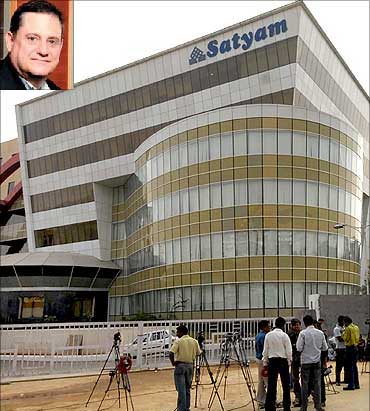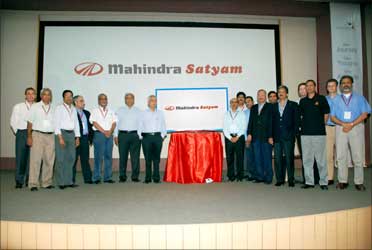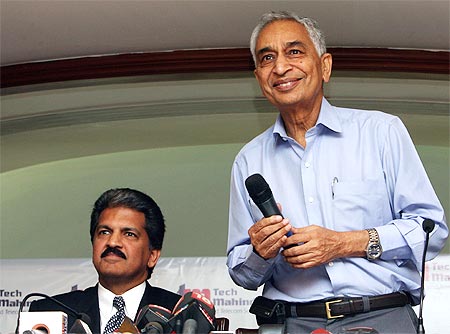
Talent executive Ed Cohen was chief learning officer and Priscilla Nelson, global director of people leadership at Satyam Computer Services when its founder, B Ramalinga Raju, confessed to long-standing accounting fraud and was subsequently jailed.
The media focused on the scandal, but how did the company deal with the crisis internally?
Cohen and Nelson have distilled their experience from those tumultuous days into lessons for corporations in a co-authored book Riding the Tiger: Leading Through Learning in Turbulent Times. They discuss some of their key learnings with Business Standard.
. . .

Cohen: Many of the things that we learnt would work in any circumstance, not only during crises.
What gets magnified during a crisis is the speed at which information needs to get out. So in normal times you might communicate with your teams on a weekly basis. Once a crisis breaks you can't make the assumption that people already know everything, so the communication has to be more frequent.
After Ramalinga Raju made his confession, we encouraged our leaders to meet with their teams hourly and then several times a day. Then we had daily meetings, then every other day and, over time, the process went back to weekly meetings.
. . .

That's very intensive. Doesn't that dissipate organisational energy when it needs to be at its peak to handle other things?
Cohen: It dissipates the organisation's energy if employees are guessing what's going on and trying to differentiate fact from fiction. People look everywhere for information when an organisation is in crisis.So you want to get information out quickly and make sure people have enough information about what's going to happen next. You don't have to disrupt things - we didn't physically get people together every hour. Instead we used a variety of means - for instance, we used web television and turned our web communications expertise into an emergency broadcast system.
Nelson: We also looked at the things we could re-use and what we needed to do simply to keep the lights on and the doors open. We called it our "lights on" strategy. A fundamental part of it was to assess what the employees needed. One of the things we advocated was to give them something that they have control over - and that is information. So if you communicate on a regular basis they know what's going on, they don't make things up.
. . .

Cohen: I agree that asking leaders to communicate as much as we did was actually counter-intuitive. Most people run away from communicating bad news - and multiply that by the fact that in certain cultures, like India, delivering bad news is not an easy thing to do.
But we were asking leaders to give their teams up-to-date information on which customers we were losing, what was happening to the leaders, what the financial situation was, whether they would get paid, whether they were going to have their jobs .
How could you communicate all this information when the answers weren't evident?
Cohen: They weren't, so the leaders needed to communicate what was possible, what wasn't and what we were looking at getting information on. The media often beat us in reporting information because Satyam was a publicly held company.
So we were often immediately validating whether that information was correct or not and sending it back out. For instance, the reports about Satyam's 10,000 phantom employees were untrue - and we told employees, "This isn't true and we're taking six steps of action to prove it."
. . .

Nelson: One of the things we needed to tell our customers is that we're still in business - and that goes to "lights on". But the important thing there was that Satyam's relations with its customers were outstanding; so the leaders and our external sales force were able to handle that aspect. We knew we needed to focus on employees because they are often the most forgotten stakeholders when an organisation goes through turmoil.
Did the attrition exceed your expectations?
Cohen: Employee attrition was far worse than hoped for but not unexpected. When Tech Mahindra came in we told them about the state of the culture in the organisation and also let them know that there is a lot of data showing that for every one person you let go, you lose three more through fear.
We tried to persuade them to calculate their let-go. They did need to reduce the size of the company - it had 53,000 people but could afford about 30,000. But the organisation let go many more people than we believe they should have.
But before that, between the time the crisis broke and the government-appointed board took over, few leaders voluntarily left - they stuck together, which is amazing. I had never seen a culture like that anywhere in the world before - people wanted to save the company!
. . .

Did the exit level exceed your expectation?
Cohen: Within the first 60 days we thought we would have as much as 25 per cent of the organisation voluntarily exit. That did not happen. There were some factors involved with that.
One is that we were constantly communicating with them, another was that the new government-appointed board made the strategic decision that there would be no lay-offs till the company was transitioned to a new ownership and we let all employees know this.
Of course, we had to take financial measures like eliminating variable pay. However, we started building a strategy for outplacement, which we didn't roll out the strategy until the job losses were confirmed. Priscilla headed up the outplacement group.
. . .

Nelson: Ten thousand people went into a virtual pool, which meant they received reduced salaries and were held in that virtual pool until a position fell vacant in Satyam.
If they were qualified for it they could re-apply. For the others we helped them write resumes, coached them in interviewing skills, dressing for success and so on. We also put all of our leaders through coaching, and all the people in the virtual pool had access to coaching as well.
Cohen: We also had a 24-hour helpline - it was more like a crisis helpline that gave referrals to counselling.
Nelson: Employees would call the helpline and people would ask them questions about the nature of their problem. If we felt they were at risk of harming themselves or someone else or creating internal problems we would refer them to a therapist in the community - many therapists just donated their time. If they were not at risk - we would address their needs through other ways.
. . .

Cohen: One of the things that we were working on when the crisis was the culture shift in the organisation. We had introduced three levels of employee commitment: Share of opportunity, which is what you get automatically when you give someone a job (the financial reward and so on); share of mind, which is what you get when the employee understand the company's vision and mission; and, third, share of heart, which is what you get when that person feels an emotional connection to the organisation and their loyalty is very high.
We had been working very hard toward share of heart - our turnover had dropped below 10 per cent where most of our competitors were in the 20 percentile range. When the crisis occurred, one of the key learnings for us was that we had to regain share of heart very quickly because it was immediately lost, and getting it back was not the same as how we had first gotten it.
So we actually had coaches who get on the phone everyday to the leaders and ask things like - have you talked to your team today? What have you told them? What have they told you? What are you planning to tell them? Instead of feeding them what to say, we worked towards enabling them to have the confidence and the courage to say what they already knew what needed to be said.
. . .

Anything you would do differently?
Cohen: The entire chapter on organisational culture in the book is an after-the-fact learning. The concept of conscious culture versus accidental culture and the influence that leadership could have and should have had in solidifying and reinventing the culture - that's a learning that came up as we were doing the research to write the book.
Looking back, we saw the culture fall apart especially when it transitioned to the new ownership. That's because the Tech Mahindra and Satyam cultures were completely different.
Nelson: A major awakening is that organisations that go through such crises tend to shut down training and development, because they are not revenue departments. But we had so much to communicate, so many lessons, so we really feel that training and development need to be part of the process.
. . .

Cohen: We shut down all classroom training and for most training departments that would actually shut them down (Satyam had 500 people). However, we still needed to get learning to leaders and people needed to keep up with their skills. So we reinvented ourselves using web television.
We ran 24x7, talk shows, so our trainers became talk-show hosts! One programme, for instance, was "Rise of the Phoenix" which used Harvard case studies from companies that had survived crises, such as Cadbury, Coca-Cola, Tylenol, Tyco and so on. Another was "Weathering the Storm" which focused on how we explain what happened to our parents or children.
We also ran a series called "Meet the Board", where we could interview each board member on camera and people could send in questions for them. Our most popular programme, however, was "Get Moving with Rashid" - he was our fitness trainer and he did a 20-minute programme three times a day on de-stressing at your desk.